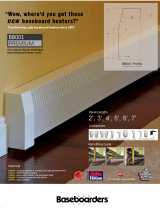4 - INSTALLATION INSTRUCTIONS
0802_GB_42 - GAS KITCHENS 04/2008
4.1 Safety rules
• Only a local gas utility technician is authorized to carry out gas
installations and connections. The statutory regulations (applied
in Germany VDE, Austria ÖVE, Switzerland SEV, etc.) and connec-
tion conditions performed by the gas utility must be strictly
observed.
• In compliance with international regulations, when connecting
the appliance to the mains power supply, a device with a mini-
mum aperture of 3 mm between contacts must be fitted
upstream of the appliance, allowing omnipolar disconnection of
the appliance from the mains. Also, a high-sensitivity automatic
differential switch must be installed which protects against direct
or indirect contact with live electrical parts and against current
leakage (maximum current leakage permissible by regulations is
1 mA/kW).
• Connection to a power balance system for the installation in a all
is given through a connection point. Follow the VDE 0100 T 410
connection rules or local rules.
• Compare technical datas on grey stickers to those written on this
manual and present power supply.
• Do not bend, crush or damage the cables against sharp corners.
• Lay the cables so as to avoid contact with extremely hot surfaces.
• Connection to the grid must be carried out with at least a cable
type NYM or H07RN-F.
• The cable - which is totally sheathed – must be led inside the
appliance through the cable clamp and cable raceway installed
on the appliance.
• Ventilation system installation can be carried out only by expert
personnel.
• If the appliance is to be installed near walls, dividing walls, kit-
chen equipment or decorative panelling, these should be in non-
inflammable material. If not, all appliances must be coated with
thermal-insulation fireproof material. Make sure that all fire pre-
vention standards and safety precautions are strictly adhered to.
4.2 Structure, equipment and safety devices
of the unit
Robust steel frame, with 4 height adjustable feet.
Steel outer panelling.
4.2.1 Cooking zone
• Burner with stabilized flame.
• Gas cocks with safety and adjustable from maximum to minimum.
• Thermoelectric ignition safety.
• Enamelled cast-iron pan supports.
• The bodies of the burners and the injector-holder cups are made
of aluminium, the flame spreaders are made of enamelled cast-
iron.
• 18/10 chrome-nickel steel cooking top.
• Knobs in thermosetting material.
4.2.2 Oven
The cooking chamber is made of stainless steel.
The runners for the pans are made of chromium-plated steel.
Extractable chromium-plated steel grill.
The door, with double wall and thermal insulation, is equipped with
an insulated handle and a hinge with balanced spring.
The insulation of the cooking chamber is rockwool.
Electric version GN 1/1 ventilated
The heating element is place in the rear around the fan and is pro-
tected by a bulkhead. Temperature adjustment between 50°C and
300°C is made by a thermostat connected to a switch.
The lighting of the heating element is indicated by 2 indicator
lights.
4.3 Assembly
4.3.1 Installation premises
The appliance must be installed in a well-ventilated room, and if
possible under a range hood (check current regulations).
The appliance can be installed on its own or with other similar
equipment.
If the appliance is to be installed near inflammable walls, a minimum
distance of 150 mm around the sides and back should be allowed.
If this distance cannot be obtained, take proper heat-protection
action such as fitting tiles or thermal radiation protection material
to the walls.
Before connecting the appliance to the gas supply, check on the
data plate that the appliance is suitable and type-tested for the
type of gas available.
If the type of gas indicated on the data plate of the appliance does
not correspond to the gas which is present, refer to the paragraph
5.1.8 “Conversion and adaptation”.
4.3.2 Statutory regulations and technical requirements
During installation of the appliance, the following regulations must
be adhered to:
• Relevant legal directives;
• Local building and combustion regulations;
• "Technical rules for gas systems" worksheet;
• "Technical rules for liquid gas" worksheet;
• “Gas installations in industrial kitchens” worksheet;
• Relative accident prevention standards;
• Local gas utility regulations;
• Local building and fire codes.
4.3.3 Installation
Before installation, gas connection, power check, conversion or
adjustment and start up ask for gas supply company advice.
4.3.4 Gas connection
The R 1/2” gas connection of the appliance to the gas pipeline can
either be permanently fixed to the mains or made detachable using
an approved cock.
If hoses are used, they must be in stainless steel and in compliance
with the DIN 3383, part 1 or DIN 3384 regulations.
After completing gas connection, check for leaks using a special
leak-detector spray.
4.3.5 Smoke extraction
These kitchens are type A appliances, thus no smoke extraction sys-
tem is required.
For the ventilation of the room where the appliance is installed,
refer to related legislation.
4.3.6 Electrical connection
Before connecting the unit to the mains, check that:
• The mains voltage corresponds to the values shown on the data
plate;
• The earth is in working order;
8 · 16
















